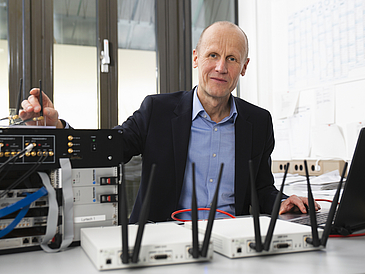The aerospace industry is changing: more and more private players are pushing their way into the state-dominated market and bringing new business models along with them. One consequence is the increased use of small satellites, which can be used cost-effectively and flexibly compared to the large and expensive satellites previously used. According to a consortium led by Professor Armin Dekorsy (University of Bremen), this trend, which is often summarized under the phrase “New Space,” will in future offer the opportunity to supply Germany with the latest generation of mobile communication (5G). Together, the participants first develop a software platform for the evaluation and optimization of the latest 5G communication technologies for satellite networks and their mission planning.
The project 5GSatOpt (Design, Evaluation and Optimization of 5G Satellite Constellations for the Internet of Everything and Everywhere) was joined by the University of Bremen, DSI Aerospace Technologie GmbH, OHB System AG, and ZARM Technik AG. The project is supported by the state of Bremen with funds from the EU ERDF program.
Opportunity for Rural Areas
The fifth mobile radio generation should ideally reach a bandwidth of 10 to 20 gigabits per second and boast various other advantages over the fourth generation (LTE). In addition to private users and industry, this is interesting, for example, for autonomously operated machines in agriculture and for the precise coordination of rescue services. Even logistics companies and shipping need the Internet of Everything and Everywhere (IoEE). Last but not least, autonomous driving can only be used where the network infrastructure is designed for 5G.
The problem: in Germany, at least 98 percent of households should be able to access 5G by the end of 2022, but only 80 percent of the area will be covered. So many rural regions are still lagging behind.
A network of small satellites can ensure complete coverage and make data transmission more efficient overall. This is possible by sending a large number of satellites – a so-called mega constellation – into a near-earth orbit and networking them with each other. “In addition to the communication level on the floor, a second level at an altitude of around 1,000 kilometers can be set up,” explains Professor Dekorsy.
Expertise Bundled in Bremen
All necessary competences for the realization of such a network are available at the aerospace location Bremen. Professor Dekorsy’s working group at the Technology Center Informatics and Information Technology (TZI) at the University of Bremen has been involved in the development of the 5G mobile radio standard from the very beginning and has the necessary expertise in communications engineering. The working group Optimization and Optimal Control at the Zentrum für Technomathematik at the University of Bremen (Professor Christof Büskens) contributes expertise in the optimization of complex systems, while ZARM (Professor Claus Lämmerzahl) focuses on mission planning. ZARM Technik addresses the alignment of satellites in space, and OHB and DSI have decades of experience in the design of satellites and communication modules.
In the first step, which began on May 1, 2019, and is scheduled to run for one year, the project partners are developing a software platform for the simulation and planning of a 5G satellite network. The platform should be able to answer questions such as: What is the maximum data rate that can be guaranteed in a region like northern Germany? How many satellites are required? What is the maximum distance between them? And how are they most efficiently networked – also with the ground stations?
Further Applications Possible without Much Effort
In addition, such a network of small satellites could also be used for other purposes, such as observing the earth and climate research. For this purpose, the small satellites only need to be updated with an additional observation module. The cooperation of the Bremen players lays the foundation for flexible and modular systems like this, which can stand out from similar projects in the USA or China due to their high degree of efficiency.
Further Information:
www.ant.uni-bremen.de/de/projects/satopt/
www.uni-bremen.de
Contact:
Professor Armin Dekorsy
University of Bremen
Technology Center Informatics and Information Technology (TZI)
Tel. +49 421 218-62400
E-mail: dekorsy@ant.uni-bremen.de

